Today marks the first day of a new fishing season, and that means licence renewal time. You may already be aware that your licence fees pay for lake stocking programs, but did you know that your licence purchase also provides funding for fish conservation projects across BC? Almost all freshwater fishing licences sold in the province include a conservation surcharge directed to the Habitat Conservation Trust Foundation. HCTF invests angling surcharge revenue into science-based conservation projects working to maintain and enhance BC’s freshwater fish and their habitats. Last year, angling licence surcharges provided approximately $2.5 Million in funding for 60 different fish conservation projects. These include:
Conference Creek Watershed Restoration Project (Vancouver Island, Approved for $42K):
Coastal cutthroat trout are a species of special concern in BC, having become locally extinct in areas of Vancouver Island and the Lower Mainland where their populations once flourished. The main reason for the species’ decline is habitat loss and degradation caused by forestry, agriculture and urbanization. The Conference Creek project is working to restore degraded cutthroat trout habitat by reconnecting creeks to their historical channels. This partnership of NGOS, government and local First Nations has identified the most productive streams in the area, and undertaken a number of restoration initiatives. These include removal of collapsed culverts, addition of cover logs, and creation of pools below the adjacent highway to provide refuge and spawning habitat for cutthroat trout and other species.
Lower Fraser River White Sturgeon Monitoring and Assessment Program (Approved for $61K): This program uses trained volunteers to apply thousands of PIT tags (similar to the implanted microchips used for pets) to white sturgeon. Regular monitoring by volunteers provides reliable estimates of sturgeon numbers in the lower Fraser River, while simultaneously increasing awareness around the conservation of this endangered species. HCTF also funds sturgeon research on the mid-Fraser River ($16K, Cariboo), with a goal of protecting important sturgeon habitats and key migration routes from development.
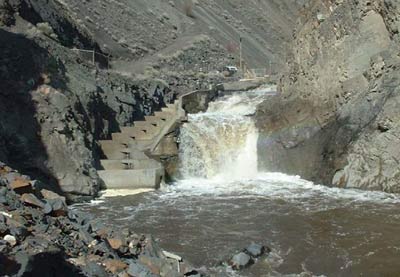
Bonaparte Dam & Fishway Operations & Maintenance (Thompson Region, Approved for $24K): The impressive Bonaparte fishway enables steelhead and rainbow trout to traverse the otherwise impassible falls of the Bonaparte River. Dam operation helps ensure drought effects on fish production are avoided or minimized. Together, this infrastructure dramatically increases the amount of available spawning and rearing habitat available to these fish, opening up over 100km of stream. On average, it is estimated that this site supports ~20% of the production of steelhead for the Thompson Steelhead catch and release sport fishery.
 Okanagan River Restoration Initiative Okanagan River Restoration Initiative ($30K): The initiative restored the dyked, straight-flowing main stem of the Okanagan River to its historic (pre-channelized) pathway over its wider, natural floodplain. The restored riverside channel, bordered by fast-growing shade forestation, follows a more meandering course with deep feeding and resting pools, and oxygenating riffles – measures which greatly improve the spawning and rearing habitat for trout and salmon. You can read more about this project here.
Okanagan River Restoration Initiative Okanagan River Restoration Initiative ($30K): The initiative restored the dyked, straight-flowing main stem of the Okanagan River to its historic (pre-channelized) pathway over its wider, natural floodplain. The restored riverside channel, bordered by fast-growing shade forestation, follows a more meandering course with deep feeding and resting pools, and oxygenating riffles – measures which greatly improve the spawning and rearing habitat for trout and salmon. You can read more about this project here.
These are only a few examples of the conservation work made possible through licence surcharge revenue. Learn more about our projects and programs here.
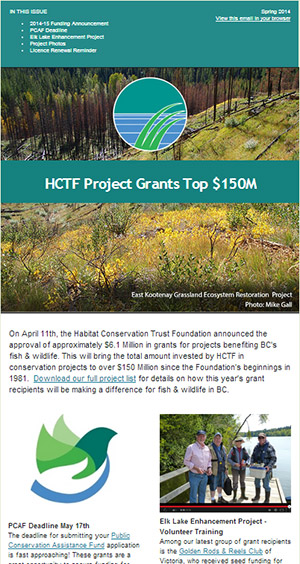 HCTF has just launched a new newsletter to keep HCTF grant recipients, partners and supporters informed about Foundation projects and news. We’ll be sending out newsletters quarterly (or when we have something really important to share). The spring edition is available here. If you would like to sign up to receive future newsletters, please use this form.
HCTF has just launched a new newsletter to keep HCTF grant recipients, partners and supporters informed about Foundation projects and news. We’ll be sending out newsletters quarterly (or when we have something really important to share). The spring edition is available here. If you would like to sign up to receive future newsletters, please use this form.




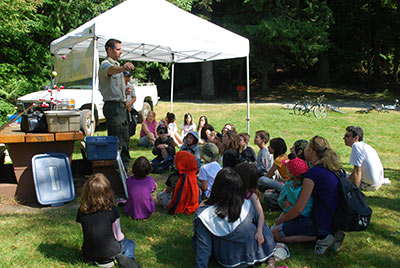
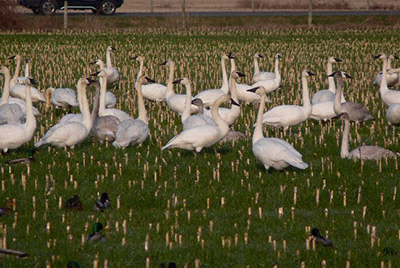

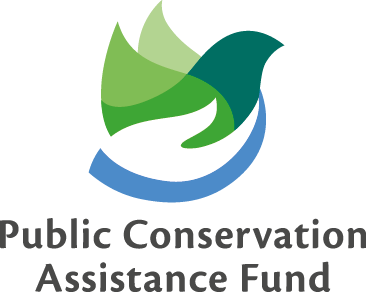

 Okanagan River Restoration Initiative Okanagan River Restoration Initiative ($30K): The initiative restored the dyked, straight-flowing main stem of the Okanagan River to its historic (pre-channelized) pathway over its wider, natural floodplain. The restored riverside channel, bordered by fast-growing shade forestation, follows a more meandering course with deep feeding and resting pools, and oxygenating riffles – measures which greatly improve the spawning and rearing habitat for trout and salmon. You can read more about this project
Okanagan River Restoration Initiative Okanagan River Restoration Initiative ($30K): The initiative restored the dyked, straight-flowing main stem of the Okanagan River to its historic (pre-channelized) pathway over its wider, natural floodplain. The restored riverside channel, bordered by fast-growing shade forestation, follows a more meandering course with deep feeding and resting pools, and oxygenating riffles – measures which greatly improve the spawning and rearing habitat for trout and salmon. You can read more about this project 



